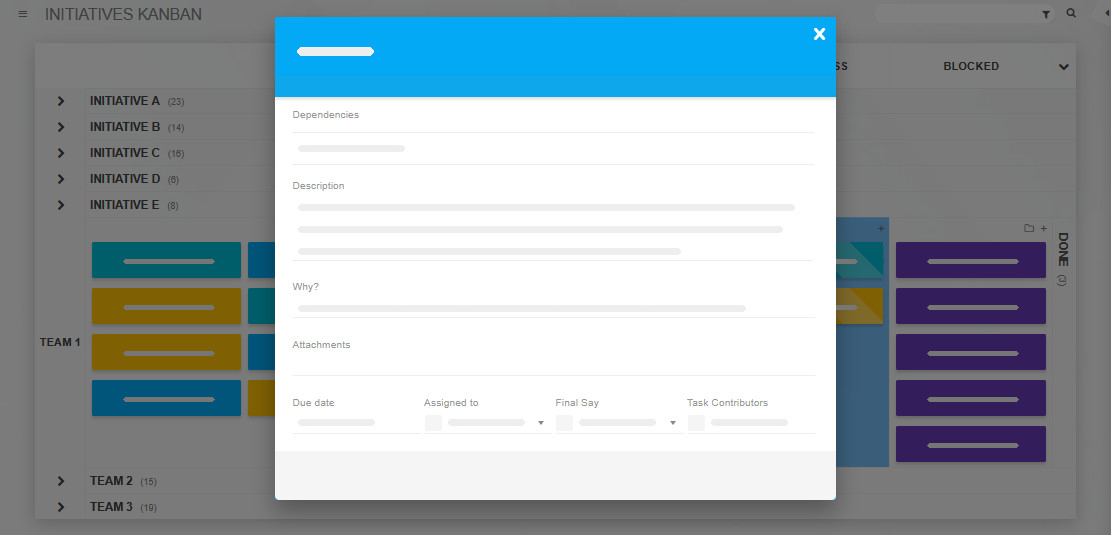Blog
Kanban for Strategic Planning: Designing Boards That Keep Teams Aligned25 Apr 2025
In most cases, the big-picture thinking happens in one room, while the real work happens somewhere else entirely. Strategic plans get written, presented, and agreed upon—and then quietly sidelined as soon as the next sprint starts. Tasks take over, the roadmap becomes a memory, and although the team gets busy, it doesn't necessarily mean it's a useful kind of busyness.

Kanban—when designed with strategic intent—can fix this. Not by adding more structure or process, but by uncovering the invisible: showing how each action connects to what the team is trying to achieve.
It isn't about using Kanban to “get more done”, but about using it to stay in sync with what matters.
Three Layers of Strategy
When your team is working off just one Kanban board, chances are it’s trying to do too much. A Kanban system that supports strategic alignment needs structure. Not complexity—structure. It could be helpful to think in three layers:
Level 1: The strategy board → Direction
As the top, high-level overview layer, it holds no tasks and moves slowly on purpose.
Build it like this:
- Columns represent strategic time horizons, e.g., This Month, This Quarter, This Year.
- Cards are strategic objectives—the big, measurable outcomes your team commits to. No fluff. No buzzwords. Make sure to express them explicitly enough to challenge and inspire, and broadly enough to last.
Also include:
- A Watch-list column for new ideas or emerging priorities the team hasn’t committed to yet.
- A Dormant or Retired column, where former priorities live after being closed or dropped. It will help you track evolution without having to rewrite history.
A board like this can work as a grounding mechanism for your team, with all significant projects or initiatives having to connect to a card here.

Level 2: Initiative boards → Movement
For each active strategic objective, create a dedicated Kanban board. It will be the mid-layer, where outcomes turn into work-streams, experiments, and deliverables.
Structure:
- Swimlanes as work-streams, with each one addressing a specific angle of the objective, e.g., “Improve Onboarding Flow”, “Reduce Churn in First 30 Days”.
- Columns will be best kept simple, e.g, Backlog, Ready, In Progress, Blocked, Done.
- Use tags to show how individual cards' success will be measured. The outcome should never be vague or abstract.
Rules:
- If a card doesn’t push forward the strategic objective—don’t add it.
- If a card gets done and nothing improves—flag it. Your focus should be on momentum, not motion.
These boards are where the team works together with intent, not just keeps busy.

Level 3: The execution layer → Reality
Here’s where the day-to-day work happens. Some teams use additional team boards for this, others utilize further swimlanes on the initiative boards for better visibility. In either case, this layer needs to live downstream from the initiatives.
What matters here isn’t volume, but traceability. Can every card be traced up to an initiative? Does every task connect to a reason?
Include:
- A “Why” field in your Kanban cards. A single sentence that answers, “What are we solving for”?
- A "Dependencies" link to an appropriate initiative card.
- A “No Upstream Link” task type—a highlight for tasks that don’t ladder up. Not meant to shame people, but to spark conversation.
Taking those steps won't mean you're now managing by policing tasks, but rather that you’re building in clarity by default!

How to run the system and keep it alive?
A full-on strategy-driven Kanban isn’t fire-and-forget. It needs rhythm and much looking back & around, but not the kind of rhythm that adds ceremony for ceremony’s sake. It's better to think of it as pulse checks:
- Monthly strategic board reviews.
Are the right objectives active? Have any drifted into irrelevance? Is the watch-list worth promoting? - Bi-weekly or weekly initiative board stand-ups.
It will be important not just to ask “What’s next”?—but “Is this still the right next”? - Daily or asynchronous execution updates, reporting on Short, visible movements.
If progress is slow, is it just misalignment, or a true blocker? - Keep in mind all of these retrospectives must be open to team friction.
If everyone has to remain overly agreeable, the board can become decoration, and the work unmotivating.

Culture check—the board reflects the team
A Kanban system is just lines on the screens and colorful task cards. The real substance of the board is how your team relates to it.
- If nobody updates it, it’s probably not useful.
- If everything is always “In Progress”, you might be spreading too thin.
- If tasks flow but strategy stalls, you’re executing without direction.
- If strategy shifts but work doesn’t, you’re lagging behind reality.
A well-structured strategic Kanban won't only reflect what you’re doing—it will also help you notice what you’re avoiding, and might even be able to shed light on why.
Less theater, more truth
Most teams don’t need new frameworks. They need better conversations, more visible connections, and—most of all—the discipline to maintain that visibility over time. A Kanban system built for strategic alignment does precisely that, provided that you treat it like a read on the team’s pulse—not a box to check.
Use Kanban to see what matters, to argue well, and to remember the end goal behind all you do.
Sign up for a 14-day free trial
to test all the features.
Sign up now and see how we can help
your organization deliver exceptional results.